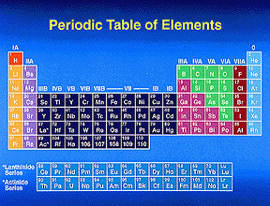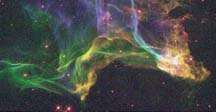Background: Dispersion of Elements
The Dispersion of Elements
| In addition to making elements, supernovae scatter them. The elements that are made both inside the star as well as the ones created in the intense heat of the supernova explosion are spread out in to the interstellar medium. These are the elements that make up stars, planets and everything on Earth -- including ourselves. Except for hydrogen and some helium created in the Big Bang, all of the stuff we, and the Earth around us, are made of, was generated in stars, through sustained fusion or in supernova explosions. |
Enrichment of the Space Between the Stars
How do the elements that are released in the wake of a supernova explosion end up in the make-up of a planet like Earth? Though we normally think of space of being empty, it actually isn't. It might seem empty since the average particle density of interstellar space is around 1 atom per cubic centimeter, but there are some 1037 tons of this thin matter in our Galaxy alone! We call the matter that fills the space between the stars the "interstellar medium" or ISM.
 | Supernovae change the chemical composition of the ISM, by adding elements which were not present before, or were only present in trace amounts. Though these explosions only occur a few times a century in our Galaxy, they are responsible for the synthesis of all the elements heavier than iron, including many we come across in daily life, like copper, mercury, gold, iodine and lead. Most of the elements which are produced in supernovae have small cosmic abundances and very few have been directly detected in the interstellar medium. The ISM is also enriched in other ways, by stars losing mass due to the solar wind for example, but supernovae are the main means in which it becomes enriched with heavier elements. |
The gradual enrichment of the interstellar medium with heavier elements has made subtle changes to how stars burn: the fusion process in our own Sun is moderated by the presence of carbon. The first stars in the Universe had much less carbon and their lives were somewhat different from modern stars. Stars that will be formed in the future will have even more of these heavier elements and will have somewhat different life cycles. Supernovae play a very important part in this chemical evolution of the Universe.
Chaos and Structure
 The Crab Nebula | The chaos caused by supernovae, like the one that created the Crab Nebula (shown at left), is also responsible for the complex structure of the ISM. A supernovae creates shock waves through the interstellar medium, compressing the material there, heating it up to millions of degrees. Astronomers believe that these shock waves are vital to the process of star formation, causing large clouds of gas to collapse and form new stars. No supernovae, no new stars. |
| What is the time scale? In tens of thousands of years after the initial explosion, a supernova remnant may grow to 100 light years in diameter. A few hundreds of thousands of years after the explosion, the ejecta will eventually mix in with the general interstellar medium. The supernova has thus enriched the interstellar medium with heavy elements across a sphere a thousand light years across or so. This means that millions or even billions of years may elapse between the supernova explosion that creates an atom of gold, for example, and the formation of the solar system where the atom eventually ends up. That's a long time! In this amount of time, a star can circle the Galaxy several times - and two stars that started off being next to each other may have ended up on the opposite side of the Galaxy! |  Credit: J. Hester (ASU), NASA |
It is impossible to speculate which specific supernovae created the heavy elements that ended up in a specific solar system; the heavy elements that are in your body and in objects around you, are the products of many different supernovae over many millions of years all over the Galaxy. Over many millions of years, the intersteller medium is continuously enriched by thousands of supernovae. That makes it all the more amazing when one tiny corner of the intersteller medium becomes dense enough, and a solar system is formed.
For the StudentUsing the text, and any external printed references, define the following terms: supernova remnant, interstellar medium, light year. |
Reference URLs:
Supernovae
http://imagine.gsfc.nasa.gov/science/objects/supernovae1.html
http://imagine.gsfc.nasa.gov/science/objects/supernovae2.html
Life Cycles of Stars
http://imagine.gsfc.nasa.gov/educators/lifecycles/stars.htm
Element Production in the Universe
http://zebu.uoregon.edu/disted/ph123/l10.html
http://aether.lbl.gov/www/tour/elements/stellar/stellar_a.html
Back to the Main Spectra Unit Menu

